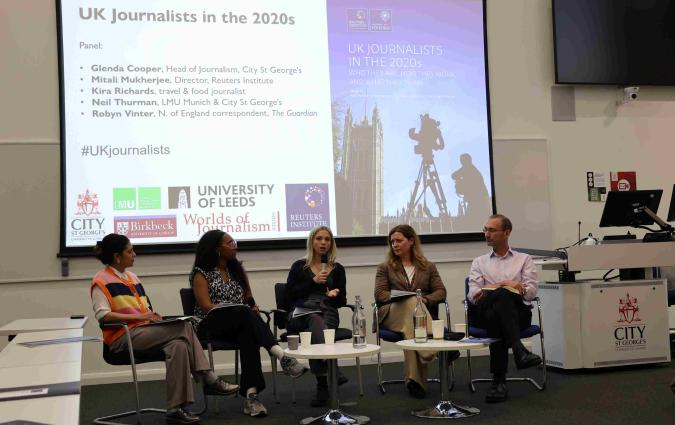In a nation polarised by COVID-19, Canadian women journalists suffer online abuse

Counter-protesters disrupt a rally held by opponents of the COVID-19 vaccine and mask mandates in downtown Vancouver, Canada. REUTERS/Jennifer Gauthier
As hundreds of truck drivers started protesting against COVID-19 mandates across Canada in January 2022, newsrooms and journalists covering the demonstrations did not know they would be specifically targeted by the protestors. About a dozen journalists covering the protests were harassed, threatened or bullied online.
Raisa Patel, a national politics reporter with the Toronto Star, started covering the protests when they started. In person, she received a death threat and was severely abused online and over email. “Most of the harassment was focused more on accusing me of being a liar, peddling fake news and disinformation and that I should be ashamed of myself and other sorts of sentiments.”
In the days to follow, thousands of Canadians joined the protests, disrupting movements and businesses and demanding an end to the COVID restrictions such as face masks and vaccine certificates. “The event in itself was very anti-media,” Patel said. “The protestors clearly had an anti-media sentiment. They were hostile and aggressive towards members of the media. You couldn’t put something up on Twitter [about the protest] without getting an army of people coming after you.”
In order to avoid being attacked or harassed, Elizabeth Payne, a health and general reporter with the Ottawa Citizen, had to make a difficult decision: not to wear a face mask. “I did feel I was putting myself at risk,” she said. “It was crowded, there were times when it was volatile. I would have preferred to wear a mask because infections were on the rise. But I knew it was a barrier that would make it harder for people to talk to me.”
Payne got attacked online after sharing a story about an ambulance being pelted with rocks. “This has a way of silencing our voices and making it tough for us,” she said. “The attacks tend to focus on the fact that you are a woman.”
A familiar trend
Harassment of women journalists in Canada didn’t start with the protests against COVID-19 restrictions. Journalists have been racially abused and targeted with hateful language, and their stories have been labelled as fake by online trolls who feel a piece of journalism is not in their favour.
“This was something that was happening every now and then, but it got amplified during the protests,” Patel said. “Just by being a journalist today, you open yourself up to the reality that you are going to get harassed over email, Twitter or other social media, and sometimes even in person just for doing your job or writing a fair story.”
The stories of Patel and Payne are not different from the lived experiences of female journalists in Canadian newsrooms. A 2021 survey of more than 1,000 journalists and media workers in the country, conducted by Ipsos, shows a growing online bullying campaign, including offensive messages targeting gender or ethnic identity, that leave many women and minority journalists struggling with mental health challenges.
The survey, the first-ever Canadian survey of online harassment against journalists and media professionals, further showed that women journalists who are Black, Indigenous, people of colour and identify as part of the LGBTQ2+ community are more likely to face intense online harassment.
“It was focused on my role as a journalist and less on my identity,” Patel said. “I am a woman of colour and that occasionally would reflect in the messages and attacks that I receive, like asking me to go back to where I come from and who am I to talk about events happening in Canada when I am not even from here.”
The survey also found that more than 70% of media workers reported experiencing harassment in the past year with cyberbullying campaigns the most common: 65% of the journalists were subjected to online vitriol, physical harassment, and threatening phone calls.
“It's really sad and troubling as to the degree to which this has been almost normalised,” said Brent Jolly, president of the Canadian Association of Journalists (CAJ). “I think this is a larger problem than we originally thought it was and part of the reckoning that we have to take on particularly.”
Behind these attacks, Jolly said, are often people who choose to remain anonymous to intimidate and ultimately obstruct journalists from doing their jobs. “That is unacceptable in a country like Canada and we need to take a step back to figure out how to address this problem,” he said. “We need to make sure that there are protections in place, so people can go about doing their jobs in a way that upholds the democratic principles of free and independent media.”
A bigger issue
This worrying trend goes beyond Canada. In 2021, a report by Reporters Without Borders [RSF] showed that 60 of the 488 detained journalists globally were women, the highest number of female journalists to be jailed that the media watchdog has ever documented.
“When it comes to gender harassment and attacks online against women journalists, there is no borders,” said Rachel Pulfer, the executive director of Canada-based Journalists for Human Rights [JHR], a nonprofit which has been working to promote the rights of journalists through development initiatives. “It was the most consistent findings across a number of indicators that women journalists – whether young or old, Global South or Global North, are targeted at a rate three times higher than their male counterparts. So, it doesn't matter if you are a veteran or straight out of J-School, you are more likely to be harassed.”
A report by UNESCO said the online attacks are common and linked with disinformation and populist politics. The report analysed 2.5 million social media posts and surveyed respondents from 125 countries. Findings show that 73% of respondents identifying as women said they had experienced online violence.
In 2021 Pulfer published a research paper which looked at threats facing women journalists and how to address them. “The statistics are pretty grim and concerning,” she said. “I thought that this paper will be a substantive contribution to the ongoing conversations on issues facing women journalists in Canada.”
Pulfer currently leads her organisation as part of a Global Affairs Canada-funded initiative to address issues of harassment of women journalists with a focus on Kenya, Tunisia, Congo, Democratic Republic and the Middle East region.
“The fact that women journalists continue to face this kind of abuse was of interest to me and us as an organisation, especially trying to understand it and the numbers around it and what this means for the future of journalism,” she said. “I've had discussions with prominent female journalists who tell me they do not belong to social media because of online attacks and hate.”
Pulfer adds that the kinds of anger and aggression expressed towards journalists during the anti-COVID restrictions protests were “unimaginable and took a gender dimension.”
Patel said attacks against journalists in Canada became exacerbated during the presidency of former US President Donald Trump. “I would say the issue facing women journalists here is a fairly big issue,” she said. “We saw that sentiment at quite an intense level in the United States and it seems to have sneaked across the border into Canada. It's an issue that affects all journalists. No matter who you are or what you are writing about, you would receive a flavour of anger and distrust from the public.”
Jolly said some politicians are instigating these attacks. In 2021 Twitter deleted a tweet by Maxime Bernie, a Canadian politician who attacked three journalists and shared their contact details on the social media platform.
“I think there is a reciprocal thing going on here,” he said. “People look to political leaders for leadership. What Maxime Bernie and others like him do when they attack journalists goes a long way to legitimise these sorts of messages. That's troubling in its own right. This is the playbook of how leaders and dictatorships in totalitarian countries go about attacking the media and their credibility to reinforce their own messages.”
Jolly said it’s fascinating and quite disturbing to see the extent to which these discussions become normalised. “This becomes so personal. People who ascribe to these views take it very personally and that's not what journalism is about. People can criticise and disagree. This is the marketplace of ideas. But it’s the personal attacks and making threats against journalists for the very fact that they are women, indigenous or people of colour that is just unacceptable. We can't allow this kind of thing to take hold if we are going to preserve our democracy.”
Fixing the problem
Jolly said that tackling this issue is a collective responsibility. Everyone must step up to end the ongoing harassment against journalists, but it’s going to take a lot of rethinking of structures that currently exist. “Newsrooms need to play their part through digital security training, mobilisation and legal support,'' he said. “How do you support your reporters who are doing these stories and are facing attacks? This is very important.”
“News organisations,” Jolly added, “are understanding that there are costs in putting journalists in the field. They are living and breathing human beings and not robots, so we should make sure that they have the protection and support they need, including mental health services and rapid responses when they face these attacks. The future of our democracy is at stake.”
Pulfer noted that newsroom leaders are struggling to address this challenge. She added that they should partner with some of these online platforms on how to reduce the barrage of attacks against women journalists. “A lot of this happens online and it is known that authoritarian regimes deliberately coordinate gender attacks against women journalists and newsroom leaders,” she said. “It would be appropriate for these platforms to make that a point of policy to address that issue because it does have a chilling impact on the productivity of these journalists.”
Patel thinks more women journalists should speak up when being harassed, but she acknowledges many people remain silent. “Nobody wants to be seen as weak or showing someone that they can't handle a situation,” she said. “There is a desire to be strong and keep yourself together. It affects everyone, but I think it does have a higher impact on women. And I think those are very entrenched ideas in the journalism profession that we should be paying more attention to.”
Pulfer discourages this culture of silence. “Journalists should never be in a position where keeping quiet is what they have to do because a lot of women journalists have been behaving exactly that way and that is not the right way to tackle it,” she said. “They should report the threats. They should screenshot and document them. They should see if they can figure out where the threats are coming from.”
Patel suggests the solution has to start inside the newsrooms. “We need to create an environment where journalists can feel comfortable going to a newsroom leader and discussing what they are going through and know that they are going to be supported. She added that a lot of newsrooms are “having those discussions right now'' and are “working on tools, solutions and processes on how to handle such an influx of abuses targeted at journalists like me.”
In every email we send you'll find original reporting, evidence-based insights, online seminars and readings curated from 100s of sources - all in 5 minutes.
- Twice a week
- More than 20,000 people receive it
- Unsubscribe any time







